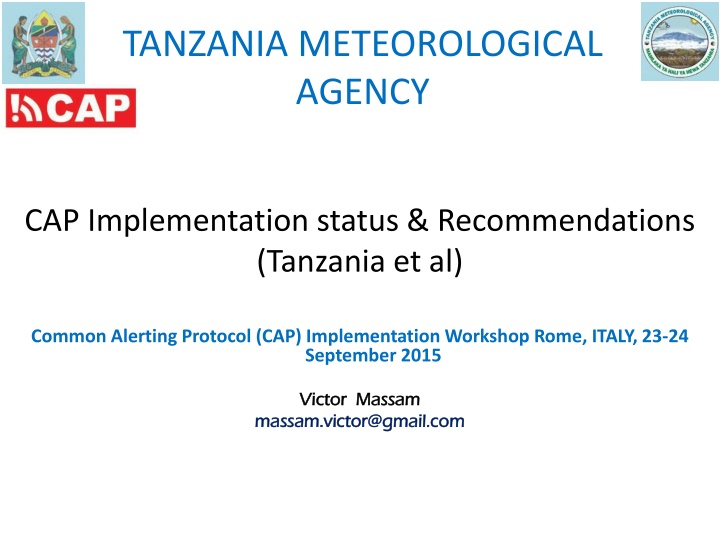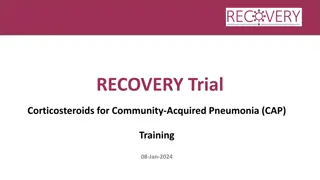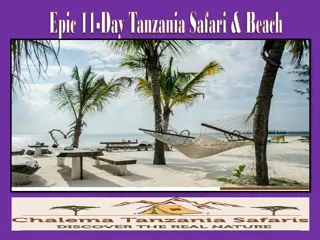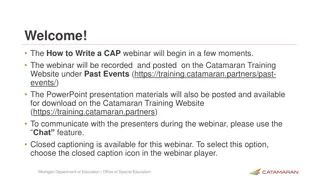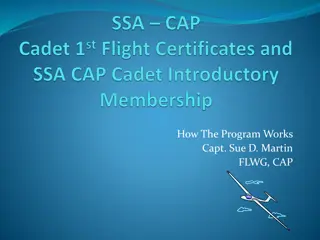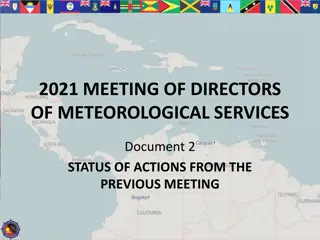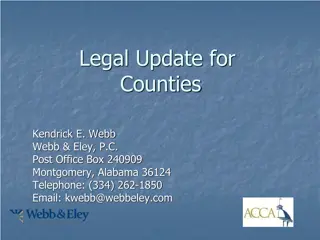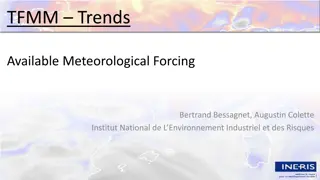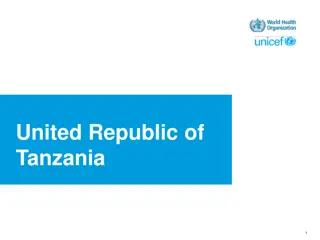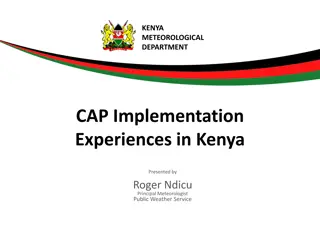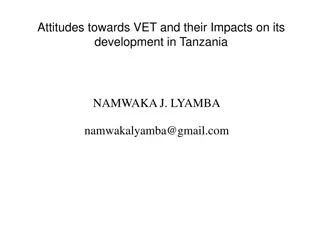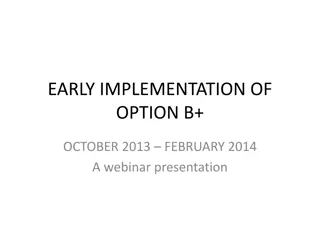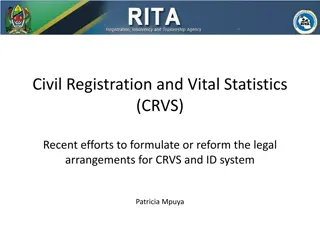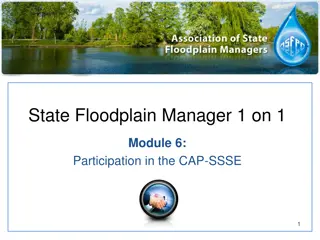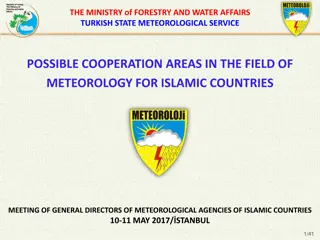Implementation Status and Recommendations for CAP in Tanzania Meteorological Agency
Tanzania Meteorological Agency has successfully implemented the Common Alerting Protocol (CAP) under the Meteorology category, enabling timely dissemination of information to the public through various media channels. Recommendations include protocol adoption, system availability, promotion through social and mass media, and real-time message delivery. Implementation workshops and stakeholder engagement have been vital in driving the adoption of CAP in Tanzania and other countries in the region. The status of CAP implementation across different countries in Africa is detailed, highlighting the progress made and areas for improvement.
Download Presentation

Please find below an Image/Link to download the presentation.
The content on the website is provided AS IS for your information and personal use only. It may not be sold, licensed, or shared on other websites without obtaining consent from the author.If you encounter any issues during the download, it is possible that the publisher has removed the file from their server.
You are allowed to download the files provided on this website for personal or commercial use, subject to the condition that they are used lawfully. All files are the property of their respective owners.
The content on the website is provided AS IS for your information and personal use only. It may not be sold, licensed, or shared on other websites without obtaining consent from the author.
E N D
Presentation Transcript
TANZANIA METEOROLOGICAL AGENCY CAP Implementation status & Recommendations (Tanzania et al) Common Alerting Protocol (CAP) Implementation Workshop Rome, ITALY, 23-24 September 2015 Victor Victor Massam Massam massam.victor@gmail.com massam.victor@gmail.com
Tanzania has implemented Common Alerting Protocol (CAP) under Meteorology category where is used by various Media to reach stakeholders
Television Timely Dissemination Information, Alerts, and Warning to the Public for the Protection of Life and Property Radio Alerting Source Direct Farmers(SMS) Common Alerting Protocol (CAP) Telephone Operators Website, Mailing List, RSS Feeds TMA Social Media Disaster Recovery Department Red Cross , DCs, RCs Newspapers 3
Implementation has taken place in some other countires i.e. Tanzania, Rwanda, Burundi, Mauritius, Malawi, Zimbabwe and, in October 2015, Botswana will be covered (Sponsored by WMO)
IMPLEMENTATION 1. CAP Jump start workshop ICT Department of the beneficiary country itself installs CAP to live server, testing Stakeholders/Mass media Discussions 2. Social media training and Adaptation: Combination social media (YouTube, Face-Book, Blog and Twitter : CAP feed is sent to social media to reach as large population as possible 3. Conducts Stakeholders Workshop (Disaster Departments, Meteorology and Mass media and Users ( to make System awareness and the following recommendation were addressed:-
General Recommendations to alerting authority:- 1. Protocol Adoption: Construct message in CAP , share to all media available and stakeholders 2. Availability: Alerting authority shall ensure CAP Feed system is up and running and internet connected to ensure continuous access 3. Promotion: Promote to as many users as possible by using Social media / Mass Media 4. Real time delivery: Users shall install RSS Feed plug-in to ensure real-time messages to their browsers and smart phones
CAP STATUS: (Tanzania et al) Tanzania Rwanda Burundi Mauritius Malawi Zimbabwe Botswana YES YES YES YES YES YES No CAP Jump workshops YES YES YES YES YES YES No Installation/ Customization YES YES YES YES YES YES No CAP in operational YES YES YES YES YES YES No Promotion (Users involves) YES YES YES YES YES YES No Registrations: Alerting Authority YES YES YES YES YES YES No English and Local Language YES YES YES YES YES YES No Include multimedia effect on CAP message (YouTube used reflect CAP format) No No No YES YES YES No Use Upgraded Freeware
CAP in Zimbabwe: (Detailed Case) This included CAP Jump Start workshop, and a Users Engagement workshop Zimbabwe
CAP in Zimbabwe: (Detailed Case) Feeds is avalable to the public
CAP in Zimbabwe: (Detailed Case) Styled formarted feeds is available to the public
CAP in Zimbabwe: (Detailed Case) Training technique on CAP Editor: English and Local Languages Shona and Ndebele
CAP in Zimbabwe: (Detailed Case) Mobile and Browsers feeds plag-in to users Custom alerting Hub Can Created within alerting authority Meteorology CAP Feeds Agregetor Flood Prime Minister s Office(PMO) Food and Nutrition So many Others
Challenges 1) Sometimes power cuts and Internet problem 2) ICT Policy review (IP address, Domain Name, Web resources and routing protocol) 3) If Website is hosted by ISP, access for CAP installation is difficult thus a dedicated hardware is required 4) Require risk recovered mechanism (Backup)
Recommendations 1. CLOUD Computation Receive Services an d Publish Alerts Freeware Note: Shall not replace CAP basics TMA Push updates Botswana N Developers
or 2. Using WMO Alerting hub WMO Feeds Aggregator
3. Smart Phone Alerts and Information (Under Constructors) Case Tanzania: According to quarterly statistics report released by Tanzania Communication Regulatory Authority (TCRA) shows Tanzania have 28,024,611 Mobile subscribers(60.92% of total population), 88.9% of Mobile subscribers uses mart phones. Development of Mobile weather apps will end up with people to getting weather alerts at their fingertips with a lower cost
iOS Android Windows Alerts Warning in Integration System Station and Warning: Geo- Location Offices correspondens(printing, Scanning, messging, Documents, Communications) is in fingure tips
Discussions Based CAP How can CAP benefit the Deaf? Color codes/ conventional symbols are required How can CAP benefit the illiterate? Color codes/conventional symbols are required How can CAP benefit the Blind? Audio CAP based example Mobile apps enable audio alert How does Multimedia Message CAP behave in relation to TV Presenter? Entire message should consider CAP Feeds based format Body gesture and language should reflect alert scenario Graphics used should draw audience s attention Background sound and effects should reflect related alert type
Discussions Based CAP How Can CAP quickly draw attention to the Audience? Standard color codes or Conventional symbols are essential How can GSM/Cellular users get CAP Messages? Customize CAP message to fit standard GSM and share to Mobile operator for broadcasting How can CAP message reach a remote area where there is no Power or Internet coverage? Big Challenges remain here
